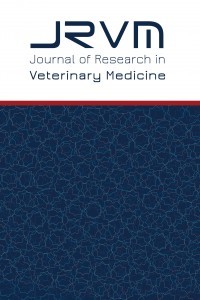Holstein-Friesian Irkı Bir Buzağıda Boynuz Köreltme Sonrası Beyin Hasarı
Boynuz köreltme, buzağı, beyin hasarı
Brain Damage Following Dehorning in a Holstein-Friesian Calf
Dehorning, calf, brain damage,
___
- Graf B. and Senn M., 1999. Behavioural and physiological responses of calves to dehorning by heat cauterization with or without local anaesthesia. Applied Animal Behaviour Science, 62, 153–171.
- Vickers K.J., Niel L., Kiehlbauch L.M., Weary D.M., 2005. Calf response to caustic paste and hot-iron dehorning using sedation with and without local anesthetic. Journal of Dairy Science, 88, 1545-1459.
- Kihurani D.O., Mbiuki S.M., Ngatia T.A., 1989. Healing of dehorning wounds. The British Veterinary Journal, 145, 580-585.
- Thompson K.G., Bateman R.S., Morris P.J., 2005. Cerebral infarction and meningoencephalitis following hot-iron disbudding of goat kids. New Zealand Veterinary Journal, 53, 368-70.
- Nation P.N. and Calder W.A., 1985. Necrosis of the brain in calves following dehorning. The Canadian Veterinary Journal, 26, 378–380.
- Wright H.J., Adams D.S., Trigo F.J., 1983. Meningoencephalitis after hot-iron disbudding of goat kids. Veterinary Medicine/Small Animal Clinician, 78, 599–601.
- Sanford S.E., 1989. Ontario. Meningoencephalitis caused by thermal disbudding in goat kids. The Canadian Veterinary Journal, 30, 832.
- Dickson J., 1984. Brain damage in dehorned goat kids. The Veterinary Record, 114, 387.
- McDannold N., Vykhodtseva N., Jolesz F.A., Hynynen K., 2004. MRI investigation of the threshold for thermally induced blood-brain barrier disruption and brain tissue damage in the rabbit brain. Magnetic Resonance in Medicine, 51, 913-23.
- Barton J.K., Rollins A., Yazdanfar S., Pfefer T.J., Westphal V., Izatt J.A., 2001. Photothermal coagulation of blood vessels: a comparison of high-speed optical coherence tomography and numerical modelling. Physics in Medicine and Biology, 46, 1665-78.
- El-Sabban F., Fahim M.A., 1995. Local cerebral hyperthermia induces spontaneous thrombosis and arteriolar constriction in the pia mater of the mouse. International Journal of Biometeorology, 38, 92-97.
- Başlangıç: 1981
- Yayıncı: Bursa Uludağ Üniversitesi
Holstein-Friesian Irkı Bir Buzağıda Boynuz Köreltme Sonrası Beyin Hasarı
Volkan İpek, Gülşah Akgül, Ahmet Akkoç, Barış Akgül
Shrink film, Depolama Süresi ve Sıcaklığının Sofralık Yumurtalarda İç ve Dış Kalite Üzerine Etkileri
Metin PETEK, Fazlı ALPAY, Serdal DİKMEN, Enver ÇAVUŞOĞLU
Broiler Piliçlerde Et Kalitesi Parametreleri
Veteriner Anatomi’de Bilgisayar Destekli İllüstrasyon Uygulamaları
Tayların Beslenmesi ve Beslenme Hastalıkları
Barış Akgül, İsmail Altuğ Şen, Hilal Çeşme, Kemal YANIK
Balarılarında Varroa destructor Enfestasyonuna Karşı Pudra Şekeri Etkinliğinin Araştırılması
Mustafa Necati MUZ, Servet ASLAN, Ahmet Onur GİRİŞGİN
Kanatlı Hayvanların Rasyonlarında Fitaz Enzimi Kullanılmasının Önemi
Sağlıklı ve Koksidiyozlu Etlik Piliçlerde Sülfakinoksalin’in Farmakokinetiği
Fatma ŞAHİNDOKUYUCU KOCASARI, Ali Bilgili
